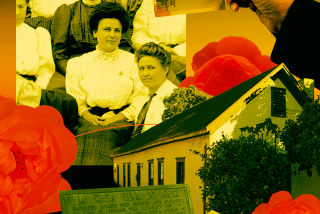LANDMARKS / COUNTY HISTORICAL SITES : The Buenaventura Mission Aqueduct
- Share via
* HISTORY: Built between 1792 and 1815 by Chumash Indians, under the direction of either a Franciscan priest from the San Buenaventura Mission, trained in hydrology, or of stonemasons brought from Mexico. The seven-mile-long aqueduct supplied water for about 350 mission residents and for crop irrigation.
* LOCATION: Only some sections have been
unearthed. It begins one mile north of the confluence of San Antonio Creek and the Ventura River, and snakes south to the mission. The largest section, the Canada Larga, is at 234 Canada Larga Road.
* HOURS: Shown by appointment only. Contact the county Cultural Heritage Board at 654-3967.
The Buenaventura Mission aqueduct once stretched seven miles to the ocean, but urban growth and vandals have reduced the county’s oldest landmark to rubble. All that remains are a few buried sections and a 100-foot-long piece protected by a chain-link fence.
The stone and mortar structure was built by Chumash Indians sometime between 1792 and 1815. Less than a quarter of a mile, including the seven-foot-high Canada Larga section, remains.
Originally, a series of channels gradually sloped from a dam on the San Antonio Creek, about one mile north of its junction with the Ventura River, to the San Buenaventura Mission. The Canada Larga section served as a siphon, drawing water uphill through covered conduits.
“It’s a remarkable structure,” said Robert Lopez, an archeology professor at Moorpark College.
The aqueduct provided a dependable water supply that allowed the mission to flourish. But it is also credited with changing the Chumash Indians from hunters and gatherers to farmers, Lopez said.
The aqueduct’s origins remain a mystery. Some historians have said construction began in 1792, 10 years after Father Junipero Serra founded the San Buenaventura Mission. Others place construction between 1805 and 1815, after the arrival of Mexican stonemasons. Another puzzle involves the design of the aqueduct. Some archeologists maintain that it was the brainchild of a Franciscan priest with military training in hydrologic engineering, while others claim it was inspired by the ancient Romans.
Sections of the aqueduct were destroyed during an 1861 flood. Later, settlers used its stones to build foundations for houses or tore it down to plant crops.
A 12-foot-wide hole was blown in the Canada Larga section in 1900 to make way for a dirt road through Weldon Canyon. Fearing further damage, officials fenced off the remaining portion in 1977, five years after it was declared a county landmark.
Archeologists have located seven sections of the aqueduct, including a ground-level stone channel, east of Ventura Avenue between Vince and Lewis streets, that served as an unpaved parking lot until the city declared it a historical landmark in 1982.
More to Read
Sign up for Essential California
The most important California stories and recommendations in your inbox every morning.
You may occasionally receive promotional content from the Los Angeles Times.









